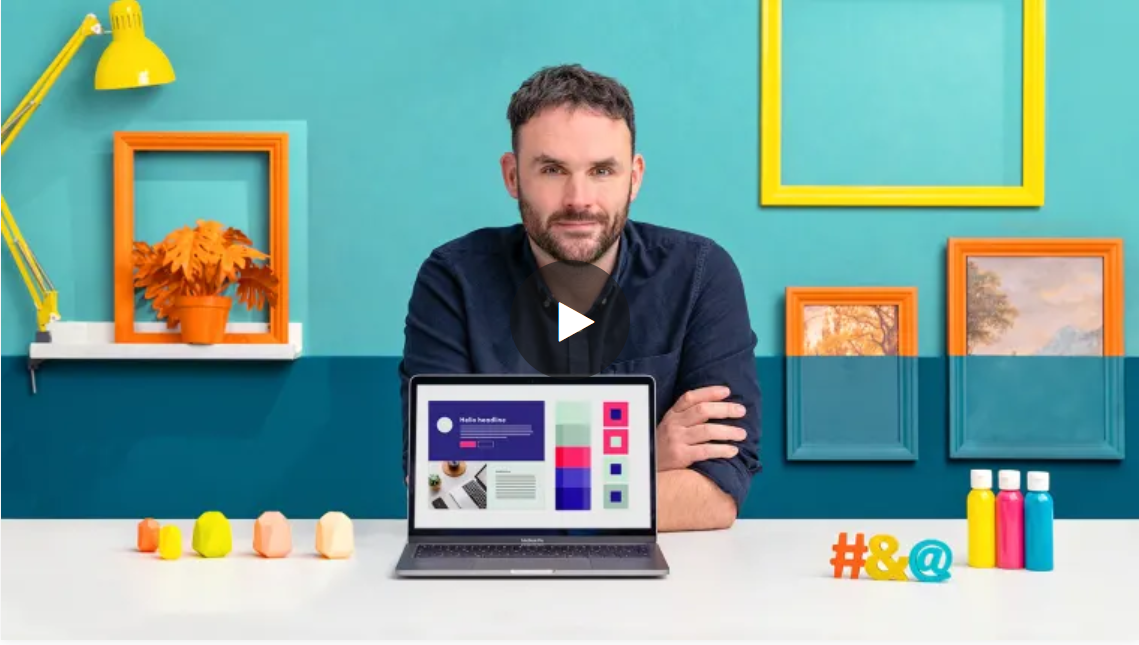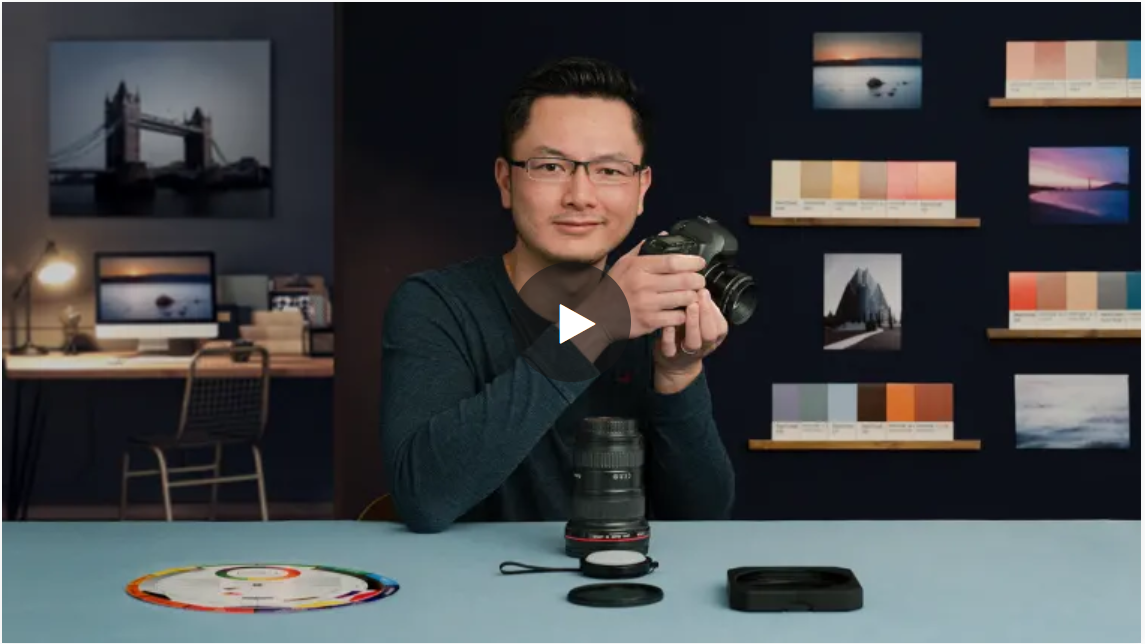- Home
- Courses
- Creative Arts and Design Courses
- Color Theory Courses
7 Best Color Theory Courses Online to Enhance Your Creative Output
When it comes to the world of art and design, there’s value to be found in going back to the basics. Here are the best color theory courses to help you improve your craft.

Color theory is an essential component of art, yet it's also a science.
Here are the best color theory courses online to help you hone your skills.
These courses cover a range of topics: including how color is formed, the relationships between different colors, how color affects human emotions and decisions, and how to use color more effectively in your personal and professional projects.
Whether you’re a graphic designer, a traditional artist, or a digital painter, these courses will open your eyes to new ways of viewing and using color.
These color theory classes are informative - but they’re not all theory - so get ready to experiment as you learn and put your knowledge into action.
What are the Best Color Theory Courses Online?
Here are the best color theory courses online to enroll in this year:
1. Color Theory Applied to Online Projects
In this engaging online course, Branding and UX expert James Eccleston teaches the big ideas behind color theory and shows you how to apply them in your own digital designs.
You'll begin the course by getting to know James, how he started off in the industry, and the designers that have influenced his work in terms of color.
Then you'll learn color terminology, how to produce a color palette, and tips and tricks for fixing bad color combinations.
Course Syllabus:
1. Introduction
2. Understanding What Color Is
- The Science of Color, What is It?
- The Basic Terminology of Color
- Color Interpretations in Different Cultures
- Color Meaning: Psychology, Culture, and Context
3. Creating and Applying a Color Palette
- Harmony: Combining Hues Using the Color Wheel
- Creating an Original Color Palette
- Applying a Color Palette to a Website
- Applying a Color Palette to an Illustration
4. Post-production
- Tips for Fixing Bad Colors and Mistakes with Digital Illustrations
- Tips for Fixing Bad Colors and Mistakes on Websites
- What are the Best Colors for Call to Action?
5. Final Project
In the final project of this course, you will create a color palette and apply it to your website design.
Note: To make the most of this course, it is recommended that you have a basic knowledge of, and access to, the following software: Adobe Photoshop and Illustrator, and your favorite between Figma, Sketch, or Adobe XD.
Key course features:
- 14 lessons (1h 48m)
- 17 additional resources (2 files)
- Online and at your own pace
- Available on the app
- Audio: English
- Subtitles: English, Spanish, Portuguese, German, French, Italian, Polish, Dutch
- Level: Beginner
- Unlimited access forever
- Certificate upon completion of the course
=> Enroll in the Color Theory Applied to Online Projects course here.
2. The Beginner's Guide to Color Theory for Digital Artists
Are you an artist that's usually satisfied with your work until it's time to add color?
If so, you're not alone.
Color can be a scary aspect of any visual art, since poor use of color can easily make or break a great drawing,
In this Udemy course, comic book colorist and art instructor Kurt Russell shows you how to practically apply color theory concepts to your digital art, so you can stop being afraid of color and start using it confidently.
Course Syllabus:
1. Getting Started (Introduction)
2. Let's Dive into Color
- The Importance of Value and Contrast - Part I
- The Importance of Value and Contrast - Part II
- Make your work look alive & vibrant with hues!
- Learn to use value and contrast as a storytelling device
- Review
- Why don't my colors seem to fit?
- Why red is weird
- Make skin look alive!
- Active & passive colors
- Color schemes
3. Special color techniques
- A palette assistance tool
- Using masks for making light and shadow
- Blending modes - Darken
- Blending modes - Lighten
- Blending modes - Contrast
- Blending modes - Color (& Level Adjustments)
4. Conclusion
In addition to real-time, step-by-step video lessons, you’ll also get:
- Line drawings for practice, so you can focus on color.
- Layered PSD files used in the lessons.
- Examples from Kurt's professional work as a digital colorist
Note: A digital drawing tablet is recommended (Wacom, iPad Pro, Huion, etc) for this course.
Although Photoshop is used mainly for demonstrations, the color theory concepts taught in this course can be applied to other popular applications such as Clip Studio, Paintstorm, Procreate, Corel Painter, Sketchbook Pro, Krita, ArtRage, etc.
Key course features:
- 3 hours on-demand video
- 3 downloadable resources
- Full lifetime access
- Access on mobile and TV
- Certificate of completion
=> Enroll in the The Beginner's Guide to Color Theory for Digital Artists course here.
3. Color theory in photography
Color has the ability to transform the way we perceive an image, and it can evoke emotions that we didn't even know existed.
In this color theory course, award-winning photographer Yaopey Yong teaches you how to apply the fundamental principles of color psychology and harmony in your photography.
A surgeon by trade, Yapoey shares his fascinating story about how he got into photography.
He explains how we perceive color on an anatomical level, and teaches you how to capture raw images in a way that tells a story.
Next, Yaopey walks you through his process when using color adjustment tools in Adobe Lightroom. You'll learn how to emphasize color in every photograph you take through the use of filters, masks, and by manipulating light and shadows.
In the final course project, you'll edit a photograph with two different editing techniques to evoke two distinct moods.
Course Syllabus:
1. Introduction
2. The Study of Color
- Fundamentals of Color
- Color Harmony Rules
- Psychology of Color
- How to Study Color
3. Capturing Light
- Capturing Raw Data
- Creating the Story
- Getting the Best of Your Camera
- Color Adjustment Tools in Editing
- Color Adjustments in Lightroom
- Color Adjustments in Lightroom 2
- Color Adjustments in Lightroom 3
- Lightness Manipulation in Photoshop
4. Reflect on Your Work
- Getting to Know Your Image
- Revisiting Edits, Is Your Image Successful?
5. Final Project
For this course, you will need a digital camera (e.g. a DSLR), a computer, and access to image editing software like Adobe Color and Lightroom.
Optional materials include a white balance lens cap and a polarizing filter. Basic knowledge of photography and image editing is recommended.
Key course features:
- 17 lessons (2h 37m)
- 19 additional resources (5 files)
- Online and at your own pace
- Available on the app
- Audio: English
- Subtitles: English, Spanish, Portuguese, German, French, Italian, Polish, Dutch
- Level: Beginner
- Unlimited access forever
- Certificate upon completion of the course
=> Enroll in the Color Theory in Photography course on Domestika.
4. Graphic Elements of Design: Color Theory and Image Formats
This course by the University of Colorado Boulder covers the design elements and uses of color, as well as graphic file formats.
Starting with the color wheel, you will review several acronyms used by graphic designers in computer programs.
You will also discover how certain colors are used for printed items and other colors are better suited for electronic mediums like television, computer, and phone screens.
By the end of the course, you will be able to:
- Select between CMYK, Pantone and RGB color options.
- Categorize the various kinds of image files and understand their usages.
- Recognize the ideal (and less than ideal) combination of graphics and text in logo design.
Course Syllabus:
- Week 1: Understanding Color Theory
- Week 2: Classifications of Images and Graphics
- Week 3: Combining Images with Type
In the last module of the course, you will get to design either a web or a sponsorship advertisement.
Key course features:
Flexible deadlines
- Reset deadlines in accordance with your schedule.
Shareable Certificate
- Earn a Certificate upon completion.
100% online
- Start instantly and learn at your own schedule.
Beginner Level
Approx. 12 hours to complete
English
- Subtitles: Arabic, French, Portuguese (European), Italian, Vietnamese, German, Russian, English, Spanish.
=> Enroll in the Color Theory and Image Formats course here.
5. Tips For Blending Traditional And Contemporary Color Theory
Next on the list is one of the highest-rated color theory courses on Udemy.
This course by Robert Joyner presents a simplified approach to color theory, and is designed to help you develop the right tools for creating more dynamic artwork.
You will discover:
- Easy techniques for blending traditional and contemporary color methods
- Tips for quality color mixing
- Ideas for exploring color using arbitrary hues
- Practical solutions for making subjects more three dimensional
- How to deal with common mistakes like muddy and garish artwork
Here are the materials you will need for this course:
- Acrylic paint (you may use watercolor but demos are completed with acrylic)
- 3 warm primaries (cad. red medium, cad. yellow medium, ultramarine blue for example)
- 3 cool primaries (alizarin crimson, hansa yellow, lemon yellow, phthalo blue for example)
- Titanium white
- 2 small sheets of drawing paper
- 3 sheets multi-purpose paint paper (140 lb. cold press - student grade)
- A selection of small and medium brushes
Key course features:
- 3 hours on-demand video
- 1 article
- 19 downloadable resources
- Full lifetime access
- Access on mobile and TV
- Certificate of completion
Overall, this course is ideal for hands-on learners who want ideas on how to explore color combinations. Whether you're a beginner or an advanced acrylic artist, there's a lot to be gained from this fun class.
=> Enroll in the Traditional And Contemporary Color Theory course.
6. Building awesome Color Schemes for your UI Design Projects
Colors are used to display and convey information, and this is particularly evident when it comes to website and mobile app design.
If you are designing for a dashboard, the color scheme you choose plays a central role in the look and feel of your user interface (UI).
This Udemy course was designed for graphic designers who are interested in shifting to UI Design, web developers who want to learn about color, and beginner designers.
As you learn the basics of color in UI design, you will discover how to:
- Craft meaningful experiences by assigning purpose to colors
- Create and mix colors in your app designs
- Improve UX and Usability by mastering color schemes
- Use Color accessibility and contrast ratios in color scheme building
Course Syllabus:
- Introduction
- Basics of Colors for UI Design
- Mastering Secrets of Color Schemes for Beginners
- Creating a Color Scheme from Scratch
- Accessible Color Schemes for UI Designs
- Managing Colors in Sketch, Adobe XD, and Photoshop
- Tools and Resources for Color Scheme Generation
Key course features:
- 5 hours on-demand video
- 3 articles
- 12 downloadable resources
- Full lifetime access
- Access on mobile and TV
- Assignments
- Certificate of completion
=> Enroll in the Color Schemes for your UI Design Projects course here.
7. Applied Color for 3D Design and Animation
How can color theory be applied in the infinite universe of 3D design and animation?
In this course, freelance 3D art and motion director Dan Zucco guides you through his creative process for building colorful 3D animations from scratch.
Using the power of Illustrator, After Effects, and Cinema 4D, he shows you how to create incredible visuals that combine geometry, movement, and color.
You'll get started by installing the necessary plugins and scripts to speed up your workflow. Then you'll learn how to create a presentation deck for your project by combining moodboards, storyboards, and a color palette.
Next, you'll create a 2D geometric design in Illustrator and discover how to model, animate, and add texture to your design to transform it into 3D.
To conclude, you'll create a colorful animated 3D loop using the skills and software taught in the course.
Course Syllabus:
- Introduction
- Design Development
- Working in 3D
- Post-production in After Effects
- Final Project
For this course, you will need a computer with Adobe Illustrator, After Effects, Cinema 4D, and a render engine. Dan uses Octane Render, but the techniques taught can easily be applied to your preferred render engine.
Key course features:
- 23 lessons (4h 3m)
- 18 additional resources (7 files)
- Online and at your own pace
- Available on the app
- Audio: English
- Subtitles: English, Spanish, Portuguese, German, French, Italian, Polish, Dutch
- Level: Beginner
- Unlimited access forever
- Certificate upon completion of the course
Final Thoughts
Color is critical to any successful design project, yet putting together the perfect color palette for a project is notoriously tough.
The purpose of color theory classes like the ones above is to provide you with inspiration and make your projects easier and more enjoyable going forward.
I hope you found a course that meets your needs and interests, and that perhaps even connects you with like-minded students and creatives from around the world.
Happy learning!
Related:
Thanks for reading! If you liked this content, share with a friend:
Recent Articles
-
The Best Python Courses Online
Apr 11, 25 10:19 PM
Here are the best python courses online to help you learn python programming and and practice your new skills through hand-ons projects and exercises. -
What I Wish I Knew About the Duality of Life
Mar 30, 25 06:06 PM
Good and bad, light and darkness, highs and lows - these are all elements of a rich, rewarding existence. Here's what I wish I knew about the duality of life. -
The Best Video Editing Courses Online
Mar 27, 25 12:14 PM
Here are the best video editing courses to help you advance from beginner to pro and create high-quality videos.





















